
* Messerschmitt attempted to build a number of follow-on fighters to replace the Bf 109, but none were successful. The Bf 109 remained the most prominent fighter of the Reich from the beginning of the war to its end, and was also flown by Germany's allies and some neutrals. After the war, some of these foreign operators would continue to build their own versions of the Bf 109, though saying they improved on it would be arguable. This chapter discusses the follow-on versions of the Bf 109; the type in foreign service; and postwar production. It concludes with a variant summary.
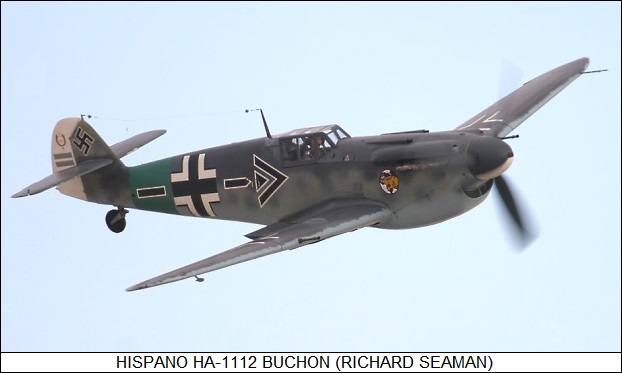
* The first Bf 109 "follow on" was the "Me 209", but it was a "follow on" in name only. The Me 209 name was assigned mostly for propaganda purposes, and the Nazi propaganda machine also gave it the even more misleading name of "Me 109R".
The Me 209 was essentially a purpose-built air racer whose only real commonality with the Bf 109 was its DB 601 engine. The Me 209 won a world speed record of 756 KPH (almost 470 MPH) on 26 April 1939. Willy Messerschmitt decided to see if the racer might make a good fighter, and came up with the "Me 209V4" prototype, which performed its initial flight on 12 May 1939. The fighter prototype strongly resembled the original Me 209 air racer, but had many changes, including a new wing, taller tailfin, and provision for two MG 17 guns in the cowling plus an MG FF/M Motorkanone.
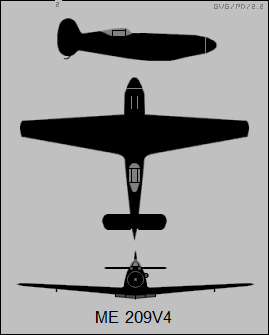
An air racer is a highly specialized aircraft -- focused on high power, relatively light weight, and aerodynamic cleanliness, at the cost of handling, range, and payload -- and is not in general much better suited to military use than is a Formula 1 race car. The Me 209V4's ground and flight handling were terrible, and successive tweaks over a year's time did nothing but raise the aircraft's weight until it couldn't win an air race against an Emil, much less the improved Friedrich that was in the works. Messerschmitt finally cut his losses and gave up on the idea.
* In late 1940, as the Friedrich was moving towards production, Messerschmitt began to consider a true successor to the Bf 109 series, designated the "Me 309". It incorporated many new features, including tricycle landing gear, an all-round vision canopy, a retractable radiator, and a reversible propeller. Many of these elements were test-fitted to Friedrichs for evaluation. When Messerschmitt proposed the aircraft to the RLM, there was no great interest; the Reich was doing so well on the battlefield that there was a dangerously complacent belief the war was all but won, and so there was no urgency to develop new weapons. The initial prototype, the "Me 309V1", didn't fly until 18 July 1942. It was fitted with a DB 603A engine.
The Me 309V1 suffered from some teething problems with the cooling system and showed some directional instability or "snaking" in flight, but the reversible propeller worked only too well. On its first test in September, it halted the aircraft so abruptly that it nosed over, breaking the nose gear and causing other damage. The prototype was laid up for repairs into November. It returned to flight status with a taller tailfin to deal with the snaking problem. Mock combat with a Bf 109G showed the Me 309 to be faster, but the Gustav could easily out-turn it.
The "Me 309V2", with the DB 605 engine intended for production aircraft, performed its first flight on 29 November 1942. It was also its last, since its nosewheel collapsed on landing and the aircraft broke in half, totaling it. The "Me 309V3" first flew in March 1943, but by this time the RLM had given up on the effort. The Me 309's performance was not enough of an improvement over that of the Bf 109G to compensate for its lack of maneuverability, and it was judged too demanding for most pilots. Ironically, the landing gear track turned out to be too wide, making it difficult to handle on the runway due to an obnoxious tendency to weave.

Messerschmitt did complete one more aircraft in the series, the "Me 309V4", which was the prototype for the proposed "Me 309A-2" heavy fighter, with an armament of no less than four MG 131s, two MG 151/20s, and two MK 108s! It performed its first flight in July 1943. The Bf 109V4 was later destroyed in an Allied bomb raid. The other two surviving prototypes were used for various experiments. Of course, proposed developments, including the "Me 309B" dive bomber and the "Me 609" Zwilling variant, were never built.
* The last evolved version of the Bf 109 that Messerschmitt tried to build was the "Me 209-II", which confusingly had nothing to do with the original Me 209 racer. The "clean-sheet" Me 309 having proven a failure, Messerschmitt decided to see if the Bf 109G design could be modified to create the next-generation fighter he had wanted.
The Me 209-II had a redesigned tail; landing gear that hinged in the wings instead of the fuselage, eliminating the Bf 109's troublesome narrow track; an uprated engine; a taller tailfin; and a DB 603 engine with an annular radiator that misleadingly suggested a radial engine. However, as design of the Me 209-II progressed, one change demanded another, and it became increasingly dissimilar to the Bf 109G.
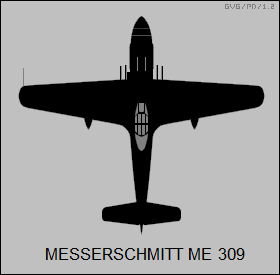
The first prototype, the "Me 209V5", following in number sequence to the entirely different Me 209V4 of 1939, took to the air on 3 November 1943. It was supposed to be the prototype for the "Me 209A-1" production aircraft, with an MK 108 Motorkanone and an MG 131 in each wingroot. A number of experimental modification kits were developed for this prototype, including MK 108s mounted in a fairing that extended back over the top of the wing. This fit actually turned out to improve the aircraft's flight characteristics, and the idea would be used on some other aircraft designs later.
A second prototype, the "Me 209V6", followed. It was similar to the Me 209V4 but fitted with a Jumo 213 engine with annular radiator, and MG 151/20s replacing the MG 131s in the wing roots. It was supposed to be the prototype for the "Me 209A-2" production aircraft.
A third prototype, for a high-altitude fighter variant designated the "Me 209H", was rolled out in the spring of 1944. The "Me 209HV1" featured extended wings and a DB 603E engine. The variant was supposed to be fitted with advanced turbocharged Daimler-Benz engines such as the DB 628A, but by late spring 1944 all work on the Me 209 had been abandoned, since its compatibility with existing production lines had almost completely evaporated. The RLM settled on the Focke-Wulf Ta 152H as the Reich's high-altitude fighter.
BACK_TO_TOP* Even from the earliest days, the Bf 109 was used extensively by Germany's allies, and some neutrals. The Hungarians bought three Doras in 1938 for evaluation. As a close German ally, they later operated large numbers of Bf 109s, acquiring Emils and then Gustavs to a peak strength of nine squadrons. The Hungarians also produced about 600 Gustavs, many of them delivered back to the Luftwaffe. Although Hungary surrendered to the Soviets in January 1945, many Hungarian units continued to fight on against the Allies from Austria. Nearly all the Hungarian Bf 109s were destroyed to prevent them from falling into Allied hands.
The Romanians obtained 69 Bf 109E-4s in 1942, and began to receive Gustavs in numbers the next year. The Romanian IAR concern assembled 30 Gustavs from kits and built 16 more on their own until Allied bombers put a stop to such activity. After Romania switched sides in August 1944, their Bf 109s operated against the Luftwaffe. The Romanian Bf 109s were obsoleted in 1948.
The Bulgarians acquired 19 Bf 109E-4s in 1940, and then acquired 130 Gustavs starting in 1943. They defended Bulgaria from American bombers, scoring at least 65 kills, though some of the Messerschmitts were lost in the air and in bombing raids. In September 1944, the Bulgarians switched sides and flew their Bf 109s against the Germans. At the end of the war, over a hundred Gustavs that had been found at an Austrian factory were passed on to the Bulgarians, though over half were given to Yugoslavia as war reparations. Bulgaria withdrew its Bf 109s from service in 1946.
73 Bf 109Es were sold to Yugoslavia and fought the Luftwaffe when the country was overrun in 1941, but spares were scarce, serviceability poor, Yugoslav pilots were poorly trained in the hot aircraft, and they offered little effective resistance against the Germans. After the war, the Yugoslavs would acquire a number of Gustavs, mostly from Romania as mentioned above, and operate them into the early 1950s.
Friedrichs and Gustavs were provided to German-allied Italian forces beginning in 1943, and the Italian pilots flew them with distinction. The German-dominated Slovak and Croat states also operated the Bf 109 under German control. Five Bf 109E-7s were provided to the Japanese in 1941, but while they were interested in the DB 601 engine and license-built it for their Kawasaki Ki-61 "Hien" fighter, they had little interest in the Bf 109 itself.
* The Finns acquired their first Bf 109s in the spring of 1943, obtaining an initial batch of 16 Gustavs. They ultimately flew 150 Bf 109s, naming the type the "Mersu", scoring 270 kills with the loss of 22 of their own number up to the time of the armistice with the Soviets in September 1944. Finnish ace Eino Juutilainen scored 94 victories, making him the highest-scoring non-Germanic fighter pilot in all history. The Finns would operate their Gustavs into the early 1950s.
The Finns were so enthusiastic about the Bf 109 that they designed their own follow-on to the type, the "VL Pyoerremyrsky (Whirlwind)". Development was protracted, with a single prototype finally flying in November 1945, after the end of the war. By that time, it was no longer needed.
The Pyoerremyrsky had an unmistakeable resemblance to a Bf 109F-series aircraft, and used a German DB 605AC engine. Its armament configuration was comparable to that of some Bf 109s, with two Finnish LKK/42 12.7-millimeter guns in the cowling and an MG 151/20 Motorkanone. However, it clearly differed in details, with a different wing planform, lengthened cockpit glazing, and landing gear hinged in the wings to give it a wider track for rough-field operation. It was also optimized to make the best use of materials the Finns had available to them, and for operation in severe winter conditions.
* Switzerland purchased a dozen Bf 109Ds in 1938, fitting them with four Swiss-built 7.45-millimeter machine guns. The cowling guns had 480 RPG while the wing guns had 418 RPG. The Doras were intended to provide familiarization for 80 Emils that followed in 1939 and 1940. The Swiss Emils were also fitted with Swiss guns, as well as a Swiss radio. The Swiss used their Bf 109Es in several furious dogfights with the Luftwaffe over airspace incursions during the invasion of France, with the Luftwaffe losing a handful of He 111s and Bf 110s, to the loss of a few Swiss Bf 109s.
Despite these fits of un-neighborliness, the Swiss obtained a dozen Gustavs late in the war. They had placed an order with the Germans in 1943 but could not get delivery, until a Bf 110 night fighter carrying sophisticated electronics and armament strayed into Swiss airspace in late April 1944, to end up landing near Zurich due to engine trouble. The Germans became more cooperative with the Swiss in delivering the Gustavs, bargaining with the Swiss for the destruction of the Bf 110 lest Allied intelligence get their hands on it. However, the Gustavs were of very shoddy quality, "hangar queens", and the Germans ended up refunding half of what the Swiss paid for them.
Swiss Bf 109s also intercepted Allied bombers that strayed into their airspace, forcing them to land and be interned. There were rarely problems, but during one such incident, a USAAF P-51D Mustang shot down a Swiss Bf 109 and damaged another. The Swiss tried painting their Bf 109s with loud red and white stripes to emphasize the Swiss cross markings, but this was discontinued, because the Luftwaffe mistook them as Allied aircraft painted in invasion stripes. The Swiss interned a number of Luftwaffe Bf 109s during the war, and even built nine Bf 109Es themselves at the end of the war, one of them assembled from spares. The Swiss Bf 109s were finally scrapped in 1949.
* The Bf 109 was manufactured by Avia in Czechoslovakia during the war. After the war, Avia continued to manufacture the Bf 109G as the "S-99", with some two-seat Gustavs produced as "CS-99s".
Avia had a stock of Daimler-Benz engines for the aircraft stored in a sugar refinery, but the refinery burned to the ground and took all the engines with it. The only alternative was a stock of Junkers Jumo 211 engines that were to have been used for He 111 bombers, and so Avia engineers mated the Jumo 211 to the Bf 109G airframe, resulting in the Avia "S-199".
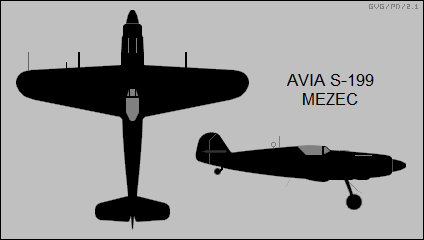
It wasn't a happy marriage. The Jumo 211 was optimized for low RPM and high torque driving a big paddle-bladed propeller, and the S-199 was a nightmare to fly, with performance inferior to a Bf 109E. Czech pilots gave it the contemptuous nickname of "Mezec (Mule)". Nonetheless, Avia built a number of S-199s and a two-seat conversion trainer variant, the "CS-199", and even sold a batch of them to the new state of Israel in 1948. The Israelis found them a threat to their own pilots and ineffective in combat, quickly phasing out the Mezecs in favor of Spitfire Mark IXs and P-51Ds.
* When the Condor Legion departed Spain after the civil war there, they left behind their Bf 109Es, making Spain one of the first foreign users of the type. The Spanish received a number of Friedrichs during the war, and in 1942 Hispano of Spain came to an agreement with Messerschmitt to license-manufacture 200 Gustavs. The consequences of this action would be lengthy, complicated, and confusing.
Hispano was supposed to get kits and assemblies to begin production, but as things went from bad to worse for the Reich, deliveries faltered. By late 1944, Hispano had 25 Gustav airframes but no DB 605s, and Hispano engineers knew they weren't going ever going to get them. As a result, they re-engineered the airframe to use the Hispano-Suiza 12Z 89 engine, with 970 kW (1,300 HP) for take-off. An Emil was fitted with the engine as an experiment and proved satisfactory, if not the equal of a real Gustav, though the new engine did improve the Emil's performance.
The Hispano-Suiza engine had a substantially different form from the Daimler-Benz engines, demanding airframe changes, and it also rotated in the opposite direction, requiring tweaky aerodynamic modifications. The first of the 25 modified Gustavs with the Hispano-Suiza engine was flown on 10 July 1947, with the designation of "HA-1109-J1L", and the rest of the batch were completed in the same configuration. However, the Spanish Air Force (Ejercito del Aire / EdA) did not regard them as satisfactory, and gave them a thumbs down.
Hispano thought the matter over, and decided to use the Hispano-Suiza 12Z 17 instead. It wasn't any more powerful than the 12Z 89, but it had many improvements, including fuel injection, and was generally regarded as more satisfactory. The company began to roll out the new variant of the fighter in 1951, giving it the designation "HA-1109-K1L", and was accepted into EdA service as the "C-4J".
* By that time, any thought of using the aircraft for air-to-air combat was completely absurd. Although one of the small batch of HA-1109-K1Ls was fitted with the intended armament of a Breda-SAFAT 12.7-millimeter machine gun in each wing, a few others in the batch were used for experiments with other armament fits to test their usefulness in the close-support role. One was fitted with twin Breda-SAFAT guns in the cowling and underwing launchers for eight 80-millimeter Oerlikon rockets, while another was given rocket launchers but no guns.
A third was fitted with one Hispano HS-404 20-millimeter cannon in each wing, plus rocket racks. The EdA found this configuration acceptable and implemented it on most of the other HA-1109-J1Ls. These aircraft were then given the new company designation of "HA-1112-K1L", though they retained the EdA C-4J designation. Two prototypes of an unarmed two-seat conversion trainer were also built, with the designation "HA-1110". The EdA also called them C.4Js.
* Even with the desired armament, the EdA did not find the HA-1112-K1L very satisfactory, and it was only used as an operational trainer. In the meantime, Hispano-Suiza then abandoned production of the 12Z engine, and so in 1953 Hispano engineers turned to the British Rolls-Royce Merlin 500-45 engine, with 1,200 kW (1,610 HP) for take-off. The British had earlier refused to provide Merlins as part of arms embargoes, but fortunately for the Spaniards the embargoes had finally been lifted.
The first conversion to Merlin power, designated the "HA-1109-M1L", took to the air on 30 December 1954 and demonstrated much improved performance, though it was still not as fast as a Gustav due to the clutter of the rocket racks and other close-support gear. The Merlin-powered aircraft went into production is the "HA-1112-M1L" and entered service with the EdA in 1956 as the "C-4K". 171 were delivered in all, some of them upgrades from Hispano-engined aircraft.
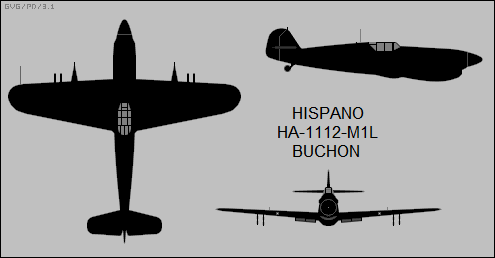
The HA-1112-M1L had a Hispano HS-404 or HS-808 cannon in each wing, with a large wing fence outboard of the gun to compensate aerodynamically for the long barrel. The aircraft had a four-bladed Rotol (Rolls-Bristol) propeller and a nose with a "deep-breasted" appearance to accommodate the Merlin, and so was known as the "Buchon (Pigeon)". Both of the HA-1110 two-seaters were re-engined with the Merlin, and were redesignated "HA-1112-M4L", though the EdA still called them C.4Ks.
___________________________________________________________________
HISPANO HA-1112-M1L BUCHON:
___________________________________________________________________
wingspan:
9.92 meters (32 feet 6 inches)
wing area:
16.10 sq_meters (173.30 sq_feet)
length:
9.10 meters (29 feet 10 inches)
height:
2.60 meters (8 feet 6 inches)
empty weight:
2,655 kilograms (5,855 pounds)
loaded weight:
3,180 kilograms (7,010 pounds)
max speed at altitude:
675 KPH (420 MPH / 365 KT)
range:
475 kilometers (475 MI / 415 NMI)
___________________________________________________________________
The first Bf 109 had used a Rolls-Royce engine, and ironically so did the last. The Buchon was phased out in 1965, a relic in comparison to the F-104 Starfighters then being operated by the Spanish Air Force. 23 Buchons were purchased for filming the movie BATTLE OF BRITAIN in 1968, and went on to private ownership as airshow trophies after that. They are almost always seen in dubious Luftwaffe markings.
* A good number of Bf 109s are on static display all over the world. Several restored Ha-1112s are still flying, and even a handful of restored Bf 109Es and Bf 109Gs are still flying.
BACK_TO_TOP* Bf 109 prototypes:
* The initial prototypes were referred to as "Bf 109As", so the first production variant was the Bf 109B or "Bertha".
* Bf 109C ("Clara") series:
* Bf 109D ("Dora") series:
* Bf 109E ("Emil") series:
* Bf 109F ("Friedrich") series:
* Bf 109G ("Gustav"):
* Bf 109K ("Konrad") series:
* Unusual variants, proposals, and derivatives:
* Foreign postwar manufacture:
* For some reason, I've never been very fond of most World War II German aircraft; nothing generally wrong with them, I just personally don't much care for their style. Despite that, the prominence of the Bf 109 makes it an essential element in any study of the topic, and there are of course many detailed sources available.
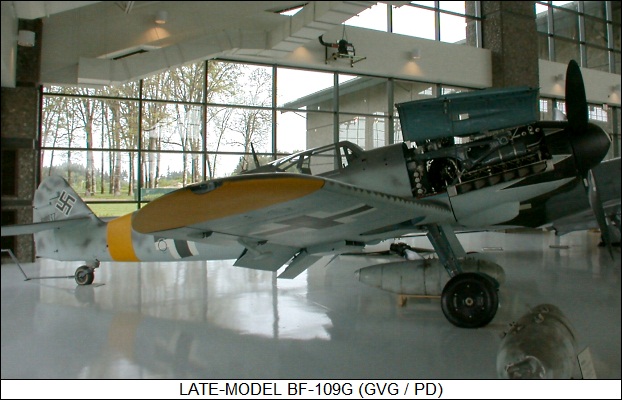
The large number of subvariants makes it something of a tricky job, and I have to admit that the subvariant list here is almost certainly not completely trustworthy. For example, most sources are fuzzy about the distinction between the MG FF and MG FF/M cannon, since the difference between the two weapons was so slight. It appears that the MG FF/M was introduced with the Bf 109E-4, and I have simply assumed that all subsequent variants specified to have the MG FF actually had the MG FF/M.
Some of the sources also had clear errors, such as claiming the Bf 109G-6/N night fighter had radar, which was implausible given the bulk of German radar sets. There were also disagreements between different sources on the nature of some of the subvariants, and some of the authors had the honesty to admit they found the whole thing extremely confusing, too.
I wasn't entirely aware of how confused the development history of the Bf 109 really was when I released the v1.0 version of the document, partly because I only used a few sources, and so didn't get tangled up in the contradictions. The v2.0.0 version of this document only started out as a minor cleanup, using some new sources, with the variant list. However, it completely spiraled out of control as I became more aware of just what a muddle the whole thing was, and ended up being a serious rewrite.
The v2.0.0 version was clearly a major improvement over the v1.0 version, which had some clear bugs, but I still had my worries. There came a time when further attempts to probe into the modification kits simply glazed my eyes over, and I could push myself no further. I've done minor updates since then and have had no inclination to do a lot of double-checking on the material, which suggests that I've learned about as much about the Bf 109 as I'm ever going to.
* Sources for this document include:
* Revision history:
v1.0 / 01 sep 98 v2.0.0 / 01 mar 02 / Added stats & variant list, cut into chapters. v2.0.1 / 01 mar 04 / Review & polish. v2.0.2 / 01 apr 06 / Review & polish. v2.0.3 / 01 mar 08 / Review & polish. v2.0.4 / 01 feb 10 / Review & polish. v2.0.5 / 01 jan 12 / Review & polish. v2.0.6 / 01 dec 13 / Review & polish. v2.0.7 / 01 nov 15 / Review & polish. v2.0.8 / 01 oct 17 / Review & polish. v2.0.9 / 01 sep 19 / Review & polish. v2.1.0 / 01 jul 21 / Review & polish. v2.1.1 / 01 jun 23 / Review & polish. v2.1.2 / 01 jun 25 / Review & polish. (*)BACK_TO_TOP
